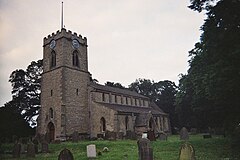Scawby
| Scawby | |
|---|---|
 Church of St Hybald, Scawby |
|
| Scawby shown within Lincolnshire | |
| Population | 2,243 (2011) |
| OS grid reference | SE968053 |
| • London | 145 mi (233 km) S |
| District | |
| Shire county | |
| Region | |
| Country | England |
| Sovereign state | United Kingdom |
| Post town | BRIGG |
| Postcode district | DN20 |
| Police | Lincolnshire |
| Fire | Lincolnshire |
| Ambulance | East Midlands |
| EU Parliament | East Midlands |
| UK Parliament | |
Scawby is a village and civil parish in North Lincolnshire, England. It is situated 2 miles (3 km) south-west from Brigg, and just east from the A15 road, and south from the M180 motorway. According to the 2001 Census, Scawby population (including Sturton) was 2,277, reducing slightly to 2,243 at the 2011 census.
The village is noted for the Nelthorpe family who owned the manor and lived at Scawby Hall. Sir John Nelthorpe founded Brigg Grammar School in 1669.
Sturton was formerly a separate hamlet a little to the south of Scawby, but development of the land between the two has incorporated the settlement into the main village. Scawby Brook, situated to the east just outside Brigg, is also partly within the parish. Also in the parish, to the west of the main village, is the roadside hamlet of Greetwell on the B1398 road.
Neolithic and Romano-British archaeological finds indicate a long history of habitation. Two mosaic floors of a possible Roman villa were found at Sturton Farm in 1816.
Scawby is mentioned seven times in the Domesday Book, as "Scallebi" or "Scalebi", with a total of 34 households.
Scawby Hall is thought to date from 1603, with an 18th-century frontage and windows, and 19th-century crenellations.
Scawby Mill, a brick-built tower mill, was opened about 1829, but the present tower was built as part of a house after the original tower collapsed during renovation work in 1994.
Scawby railway station, to the south of the village, opened in 1848, and closed 120 years later. The line is still open.
The church of St Hybald is dedicated to a 7th-century Saxon of that name. It is built in the Early English style, but was substantially rebuilt in 1843 by William Adams Nicholson, and in 1870 by James Fowler of Louth. The tower is original, of the 15th century, with 13th-century work at the base.
...
Wikipedia

